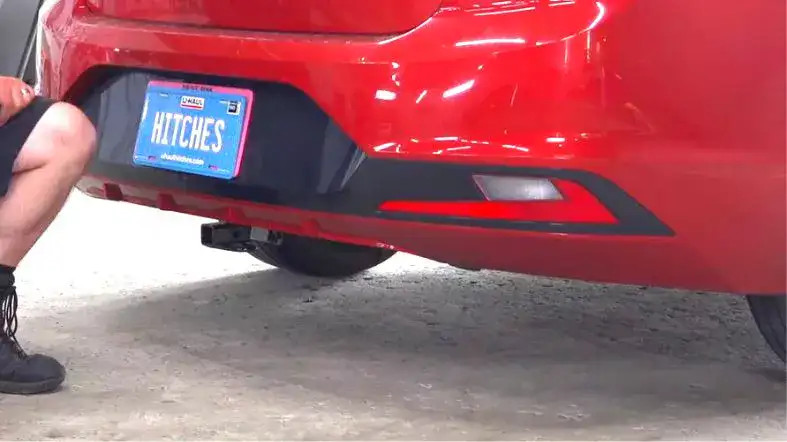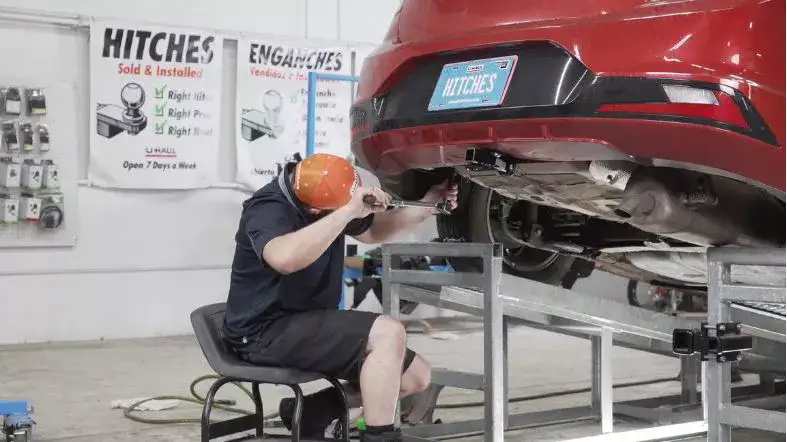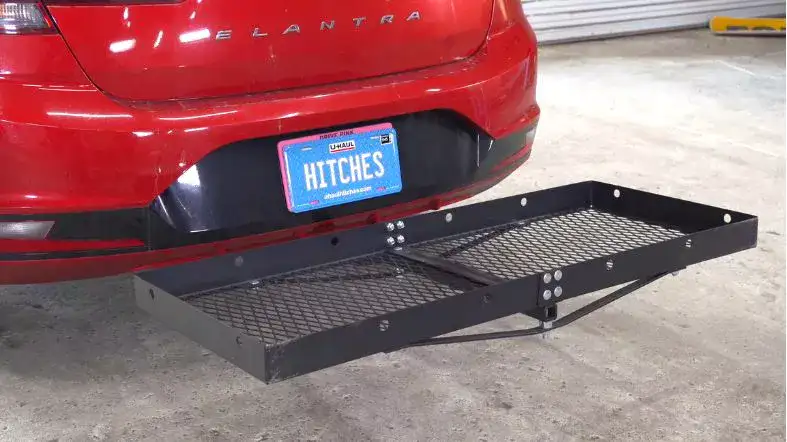If you own a Hyundai Elantra and you’re thinking about adding a hitch to your vehicle, you might be wondering if it’s even possible.
After all, not every car is designed to handle the additional weight and stress of towing, and you want to make sure your Elantra is up to the task.
In this blog post, we’ll explore the possibility of adding a hitch to a Hyundai Elantra, as well as some of the potential benefits and drawbacks of doing so.
Whether you’re looking to tow a trailer, a boat, or any other type of recreational vehicle, we’ve got you covered.
Can you put a hitch on a Hyundai Elantra?
Yes, it is possible to install a hitch on a Hyundai Elantra.
But you need to make sure that the hitch is compatible with your specific model of Elantra, as different years and trim levels may have different mounting points and load-carrying capacities.

It is also important to ensure that the hitch and any attached trailer are within the weight capacity of the vehicle.
Types of hitches available for the Hyundai Elantra
There are several types of hitches available for the Hyundai Elantra, each designed to meet specific towing needs and preferences.
Here is a detailed overview of these hitches and how they can be used:
Class I Hitch:
This is a basic hitch that is suitable for light to moderate towing tasks, such as carrying small trailers or bike racks.
It is designed to attach to the frame of the vehicle and has a maximum towing capacity of 2,000 pounds.
The Class I hitch for the Hyundai Elantra is relatively easy to install and can be mounted using common tools.
Class II Hitch:
This is a slightly more advanced hitch that is suitable for moderate to heavy towing tasks, such as carrying larger trailers or boats.
It is designed to attach to the frame of the vehicle and has a maximum towing capacity of 3,500 pounds.
Class II hitch for the Hyundai Elantra is slightly more complex to install compared to the Class I hitch, and may require specialized tools and expertise.
Class III Hitch:
This is a heavy-duty hitch that is suitable for heavy towing tasks, such as carrying large trailers or RVs.
It is designed to attach to the frame of the vehicle and has a maximum towing capacity of 6,000 pounds or more.
The Class III hitch for the Hyundai Elantra is quite complex to install and requires specialized tools and expertise.
It is also typically more expensive compared to the Class I and Class II hitches.
Class IV Hitch:
This is the most advanced hitch available for the Hyundai Elantra, designed for extreme towing tasks such as carrying very large trailers or RVs.
It is designed to attach to the frame of the vehicle and has a maximum towing capacity of 10,000 pounds or more.
The Class IV hitch for the Hyundai Elantra is very complex to install and requires specialized tools and expertise.
Class V Hitch:
This is a specialized hitch designed for extreme towing tasks such as hauling large commercial vehicles.
It is designed to attach to the frame of the vehicle and has a maximum towing capacity of 12,000 pounds or more.
Fifth-Wheel Hitch:
This type of hitch is designed for towing very large trailers or RVs and is typically mounted in the bed of a pickup truck.
It connects to the trailer using a large, pivoting plate called a “fifth wheel,” which allows for better weight distribution and stability.
Fifth-wheel hitches are typically expensive and complex hitch options.
The fifth-wheel hitch for the Hyundai Elantra has a maximum towing capacity of 20,000 pounds or more.
Gooseneck Hitch:
A gooseneck hitch is a type of hitch that is designed for towing large trailers or RVs.
It is typically mounted in the bed of a pickup truck and connects to the trailer using a ball and socket joint, allowing for better weight distribution and stability.
The gooseneck hitch for the Hyundai Elantra is a specialized hitch option that is not commonly available.
It is typically only used by professional towing companies or individuals with a specific need for extreme towing capabilities.
The gooseneck hitch for the Hyundai Elantra requires professional installation and is typically more expensive compared to other hitch options.
It also has a higher towing capacity, typically up to 30,000 pounds or more.
However, it is important to note that the Hyundai Elantra may not be equipped to handle such heavy loads and may not be suitable for towing with a gooseneck hitch.
It is essential to consult with a professional or refer to the vehicle’s owner’s manual to determine the appropriate towing capacity and ensure safe and reliable towing.
How to Install Hitch on a Hyundai Elantra?
Here, we will discuss the steps involved in adding a hitch to a Hyundai Elantra and provide some tips to ensure a smooth and successful installation process.
1. Gather all tools:
Gather all necessary tools and materials for the installation.
- Drill
- Bolts
- Torque wrench
- Screws
- Screwdrivers
- Wrenches
- Level
- Stud finder
- Measuring tape
- Protective gear

2. Lift the back of the car:
Begin by lifting the back of the car using a car jack and placing it on jack stands.
Ensure the car is securely in place and will not move while working on it.
3. Follow the instruction:
Consult the instructions provided with the hitch kit to determine the specific location where the hitch will be installed.
On a Hyundai Elantra, this will typically be just below the rear bumper, near the car’s center.
4. Create Holes:
Use a drill to create holes in the designated locations for the hitch.
Be sure to use the correct size drill bit for the bolts provided in the hitch kit.
5. Tighten the bolts:
Insert the bolts provided in the hitch kit through the holes in the car and into the hitch.
Tighten the bolts using a torque wrench and the appropriate sockets and wrenches.
6. Keep the hitch straight:
Once all bolts are tightened to the specified torque, use a level to ensure that the hitch is straight and properly aligned.
If necessary, make adjustments by tightening or loosening the bolts as needed.
7. Attach the wire:
Finally, attach any necessary wiring or electrical components to the hitch, such as a trailer light plug or brake controller.
Safety measures to consider during the installation process include wearing proper safety gear, such as gloves and safety glasses, and carefully following all instructions in the hitch kit.
It is also important to keep the car securely supported on jack stands and to never crawl under a car that is not properly supported.
What are the benefits of installing a hitch?

Installing a hitch on a Hyundai Elantra can provide numerous benefits, including the ability to tow a trailer or carry a bike rack.
Here are a few more specific benefits:
1. Increased versatility:
A hitch allows you to easily and safely attach various types of trailers to your vehicles, such as utility trailers, travel trailers, boat trailers, and more.
This can be especially useful if you frequently need to transport large or heavy items or if you enjoy recreational activities such as camping or boating.
2. Convenient hauling options:
With a hitch, you can easily attach a bike rack or other cargo carrier to your Hyundai Elantra, providing a convenient and secure way to transport your gear.
This can be especially useful if you have limited space inside your vehicle or if you want to keep your items out of the weather.
3. Easy towing:
A hitch can make it much easier to tow a trailer or other load, providing a secure connection point between your vehicle and the trailer.
This can help reduce the strain on your vehicle’s engine and transmission and can make towing safer and more stable overall.
4. Increased resale value:
Installing a hitch on your Hyundai Elantra can also potentially increase the resale value of your vehicle, as it makes it more versatile and useful for a wider range of potential buyers.
5. Professional installation:
When a hitch is installed by a professional, you can be sure that it is done correctly and safely.
This can help you avoid any issues or accidents that could occur if the hitch is not installed properly.
FAQs on Putting A Hitch On A Hyundai Elantra
Will The Hitch Fit All Model Years Of The Hyundai Elantra?
Hitches are typically designed to fit specific model years and trim levels of a vehicle, so it is important to ensure that the hitch you are purchasing is compatible with your specific model year and trim level of Hyundai Elantra.
How Much Weight Can A Hitch On A Hyundai Elantra Support?
The weight capacity of a hitch on a Hyundai Elantra will depend on the specific hitch you are using and the model year and trim level of your vehicle.
It is important to refer to the manufacturer’s specifications for the hitch and your vehicle’s owner’s manual for specific weight capacity information.
Can I Install The Hitch Myself, Or Do I Need To Have It Installed By A Professional?
While it is possible to install a hitch on a Hyundai Elantra yourself, it is recommended to have it installed by a professional to ensure proper installation and safety.
Are There Any Modifications That Need To Be Made To The Vehicle To Install A Hitch?
Depending on the specific hitch being installed, some modifications may be required to install a hitch on a Hyundai Elantra.
It is important to refer to the manufacturer’s instructions and consult a professional to determine if any modifications are necessary.
Will Installing A Hitch Affect The Performance Of My Elantra?
Installing a hitch on your Elantra may slightly affect your vehicle’s performance, as it adds additional weight and may change the car’s balance.
However, these effects are typically minimal and should not significantly impact the overall performance of your Elantra.
conclusion
Putting a hitch on a Hyundai Elantra is possible.
However, it is important to ensure that you have the proper tools and knowledge to do so safely.
It is also important to consult a mechanic or dealership to ensure that your specific model of Elantra is compatible with a hitch.
Once you have properly installed a hitch on your Elantra, you can enjoy the added convenience and versatility it provides for towing or hauling items.
